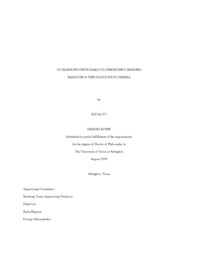| dc.description.abstract | Ultrasound switchable fluorescence (USF) imaging has been proposed as a novel imaging modality which provides microscopic fluorescence imaging in centimeter-deep tissue. USF is possible to reveal many interesting phenomena such as microcirculation, tumor angiogenesis, and cancer metastasis and diagnose early-stage cancer. USF adopts a focused ultrasound (FU) to repetitively switch “on” fluorescent agents in tissue, and the USF photons scatter out and are captured by a detector. A USF image provides acoustic resolution and optical sensitivity. In USF, there are two key components: 1) an excellent USF contrast agent; and 2) a sensitive USF imaging system. The major challenge of USF is to develop USF contrast agent with excellent USF properties and also long-term stability, bio-stability, and functionalization, as well as to develop a USF imaging system with high detection sensitivity, specificity, efficiency, and also flexible experimental operations for a desired imaging quality. In addition, in vivo USF imaging is an important step to push USF technique to future biomedical applications. This dissertation focuses on investigating and developing new USF contrast agents and imaging systems, for the purpose of improving USF imaging qualities (i.e., sensitivity, spatial resolution, imaging contrast, data acquisition time) and also its feasibility of long-term study, functional imaging, as well as in vivo USF imaging.
This work is categorized into three major parts: (I) USF contrast agents; (II) a new USF imaging system; and (III) in vivo USF imaging. In part (I), we developed two series of NIR USF contrast agents: (a) new generation ICG-encapsulated poly(N-isopropylacrylamide) nanoparticles, and (b) ADP- and ZnPc- encapsulated pluronic-based nanocapsules. We synthesized, characterized, and selects those with excellent USF properties. Meanwhile, we also discussed how their performance affected a USF image. In part (II), we developed an ICCD camera-based, time-domain USF imaging system. We demonstrated its features and advantages for USF imaging. Also, we described the tradeoffs inherent in USF imaging and suggested appropriate USF imaging strategies. In addition, based on this system, we developed several USF imaging processing algorithms for a better imaging quality. In part (III), we successfully carried out in vivo USF imaging in mice via an ICCD camera-based in vivo USF imaging system. USF imaging of tumors and in vivo organs were successfully achieved in the experiments.
In part (I)-(a), the results shows that the new generations ICG-NPs have a significantly improved shelf (> 6 month) compared to the old generation (<1 month). Also, the new generation ICG-NP is conjugated with functional groups (hydroxyl or carboxyl) and is capable of functional imaging when attached with a targeting moiety. Besides, we investigated that the effect of the temperature-switching threshold (Tth) of the agent should be slightly higher than the background temperature (TBG) for a best signal-acquisition efficiency. The Tth should be controlled around 38–40 °C for a best in vivo USF imaging. In part (I)-(b), the results show that the selected ADP- and ZnPc- encapsulated pluronic-based nanocapsules have excellent USF properties. In addition, we demonstrated that some factors: 1) pluronic categories, and 2) nanocapsules’ concentration will affect the Tths, while other factor: 3) fluorophore categories will not. The pluronics’ Tth sequence is F127 < F98 < F68 < F38 based on using different pluronics. And, a lower nanocapsule concentration brings a higher Tth. We also discussed to adopt the nanocapsules as temperature sensors. In part (II), we demonstrated the ICCD camera-based time-domain USF imaging system is appropriate for USF imaging. Meanwhile, we could balance the tradeoffs between imaging qualities (i.e., SNR, spatial resolution, temporal resolution) by adjusting experimental parameters including CCD camera recording time, FU power, imaging depth, and gate delay of ICCD camera as well as selecting an appropriate USF contrast agent. Thus, we could acquire a best USF image based on our desire. Following that, we investigated several USF imaging processing algorithms to improve USF imaging qualities including: 1) improving the SNR by a correlation method; 2) improving the spatial resolution by an ascending-slope-weighted method; 3) improving the spatial resolution by an algorithm called a spatial back-projection method. In part (III), In vivo USF imaging in the mouse’s glioblastoma tumor with one or multiple targets were demonstrated. Also, in vivo USF imaging of the mouse’s spleen and liver were achieved. The results were validated by 3D co-registration with the micro-CT images and showed in vivo feasibility of USF imaging. We adopted ICG-NP as the in vivo USF contrast agents, which shows a high bio-stability in mice’s tumor as well as spleen and liver. Finally, we discussed the advantages of the ICCD camera-based system for in vivo USF imaging. | |


